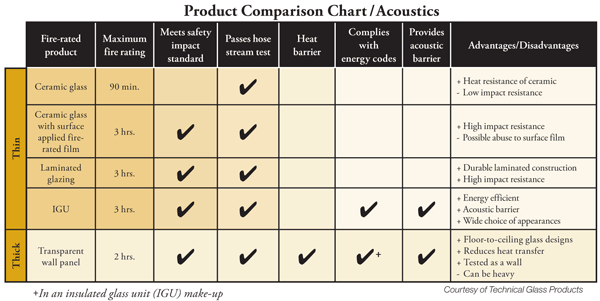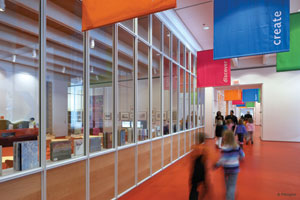Fire-Rated Glass and Framing Deliver Design Goals
"One way design professionals can demonstrate the long-term value of fire-rated glazing is to show how it's a multitasking material. Unlike gypsum and concrete, fire-rated glazing can protect against fires while helping to draw in natural light and open up interior spaces," says Jeff Razwick, vice president, Technical Glass Products. "And, when incorporated into daylighting designs, fire-rated glass has the potential to help reduce the amount and cost of artificial lighting."

Applications
Non-impact safety rating. While fire-rated ceramic glass products carry a fire-rating, not all offer impact safety. For those applications such as transoms and borrowed lites, non-impact products may be specified. (Some fire-rated ceramic glass is available with product make-ups that do provide impact safety.)
Impact safety rating. According to 2006 IBC, fire-rated glazing in hazardous locations must also pass an impact safety test. Impact safety ratings that meet the highest impact ratings of Category II (see Sidebar "Fire-Rating Tests and Terminology"), may be achieved through lamination or a surface-applied fire-rated film. Laminated products are typically thicker than standard ceramic glass, with a profile of approximately 5/16-in. compared with 3/16-in. for non-laminated products. Transparent wall panels are another choice.
High traffic areas. Ceramic glass with high impact safety ratings, as well as transparent wall panels, may be suitable for door and window applications in high traffic areas such as busy corridors and lobbies in schools and hospitals.
Doors. Because they are in a hazardous location, glazed doors, along with sidelites, that require a fire rating also must be impact safety rated. Manufacturers offer several options for fire-rated doors. Some examples are:
- Ceramic glazing material 3/16-in. thick, has a surface-applied approved fire-rated film that protects from fire on both sides of the glass and is offered in different clear-viewing grades.
- A 5/16-in. thick laminated fire-rated glazing that is rated for impact safety. May be lightly sandblasted/etched on one side without affecting fire rating.
- A third option is an energy efficient IGU.
- But the most robust fire resistant choice for door and partition glazing and wall applications with a fire rating of up to two hours is a transparent wall panel that is impact safety-rated, and tested as a heat barrier that blocks radiant and conductive heat from transferring through the glass.
Art Institute of Chicago Modern Wing |
To allow more comprehensive display views for the museum's growing number of visitors and increase educational space, the Art Institute of Chicago commissioned Renzo Piano, founder of Renzo Piano Building Workshop, to design a "Modern Wing." "My desire was to...give the Modern Wing air and lightness-to let it levitate," says Piano, "a continuation of an urban fabric, a flight into new experiences."
One challenge Piano and local architects of record, Interactive Design, Incorporated, Chicago, Ill., faced was how to maintain clear lines of sight from historic Michigan Avenue through the space to the fresh landscape of the Millennium Park Courtyard. The interior walls for the education and boardrooms needed to be transparent for much of their height and length, yet also meet fire and life safety codes. Their solution was to combine transparent wall panels with a fire-rated custom narrow-profile aluminum framing system to match as closely to the exterior curtain wall as possible. Fire-tested as a wall assembly by UL for a one-hour fire rating, the glass wall panels are an effective alternative to a solid wall. The wall panels also meet the impact requirements of CPSC 16CFR1201 Category I and/or Category II-a critical performance criterion given the location of the glazing in busy halls and activity rooms. |
Photo courtesy of Pilkington© |





 Double-layered curtain walls form the exterior of the northern and southern façades of the three-story 264,000-sq. ft. addition. Suspended above the building's glass, steel and Indiana limestone exterior is the Modern Wing's trademark "flying carpet" or rooftop canopy which filters light into the third floor galleries.
Double-layered curtain walls form the exterior of the northern and southern façades of the three-story 264,000-sq. ft. addition. Suspended above the building's glass, steel and Indiana limestone exterior is the Modern Wing's trademark "flying carpet" or rooftop canopy which filters light into the third floor galleries.



